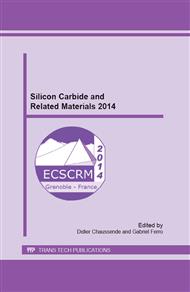p.108
p.115
p.121
p.125
p.129
p.133
p.137
p.141
p.145
Effect of C/Si Ratio and Nitrogen Doping on 4H-SiC Epitaxial Growth Using Dichlorosilane Precursor
Abstract:
Application of dichlorosilane (DCS) in 4H-SiC epitaxial growth on 4° off-cut substrates has been studied. The effect of C/Si ratio and N2 gas flow rate on epilayer properties is investigated in detail. It is found that the C/Si ratio has a significant influence on the growth rate, epilayer surface roughness (step-bunching), conversion of basal plane dislocations (BPDs), and generation of morphological defects and in-grown stacking faults. A wide range of doping concentration from p- to n+ can be controlled in DCS growth. High quality 4° off-cut SiC epilayers are achieved for C/Si=1.3 – 1.8. Addition of N2 has no obvious influence on growth rate and defect densities. The BPD conversion greater than 99.8% is achieved independent of N doping without any pretreatment.
Info:
Periodical:
Pages:
129-132
Citation:
Online since:
June 2015
Authors:
Keywords:
Price:
Сopyright:
© 2015 Trans Tech Publications Ltd. All Rights Reserved
Share:
Citation:


